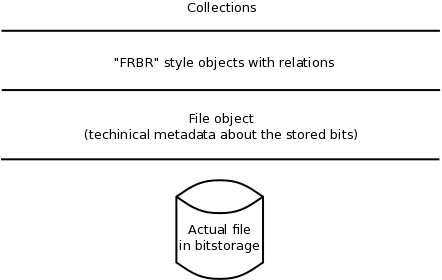FRBR Relations **
Context
When creating a data-model where many objects will be of the same work, (see Clasical Music) the use of the FRBR model can aid the planning of object relations at the levels between the collection (see Collections In General) and the file-object (see file-objects).

Description of pattern
When there is a multitude, especially of Expressions, Manifestations and Item's, of the work it can be very prudent to include a relation in the data-model to reflect this
Problem description
There are certain types of item groups within the library where there are many representations of the same work, take for instance the 7th symphony by Beethoven, an attempt to illustrate this form of construction is shown below.
Work part of DOMS meta-data |
Expression part of DOMS meta-data |
Manifestation part of DOMS meta-data |
Item fedora file-object and DOMS digitization meta-data |
A Manifestation can have several fedora file-objects, for instance recordings from Phonograph cylinders have been digitized, for some items, in multiple versions since the original playback speed is unknown.
Use the structure of the data to strengthen the data-model, consider combining one-to-one mappings into one structure in the design of the datamodel, for instance Van goghs painting Tournesols is one Work with one Expression, but several Manifestations(one painting+many photographs) and thus many Items allowing for Work and Expression to be combined into one datastructure, this will most likely apply to many paintings
Solution
Use the nature of the collection to influence the FRBR relations in order to maximize the uniqueness of each data-object in the DOMS
Consider next
This Pattern will influence the pattens within the FRBR model namely the FRBR Work, FRBR Expression, FRBR Manifestation and FRBR Item, these should not be decided on before taking the "How to use FRBR" document into account.